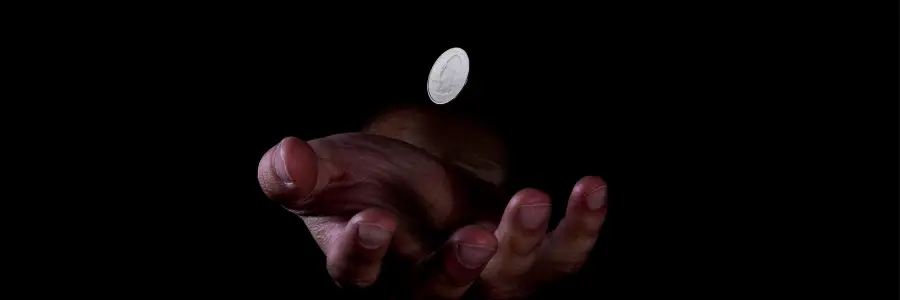The Law Of Small Numbers In Sports Betting

One of the many means by which bookmakers make a profit is punter error. Following the law of small numbers is one of the most glaring of these errors, yet most bettors either don’t know what it means or don’t give it a second thought.
In economics, the law of small numbers refers to a bias people are susceptible to when calculating probability or making predictions. A simple example is the coin toss. We know that statistically speaking, there is a 50% chance that the coin lands on heads, and a 50% chance that it lands on tails, assuming that the coin is not damaged in any way.
If you toss the coin six times and it lands on heads every single time, some people will start to get this sense that it is more likely to land on tails on the seventh toss. In reality, of course, there is still a 50% chance of the coin landing on heads.
Even people who are aware of this concept can subconsciously alter their behaviour based on the bias caused by such unexpected results. It is all too easy to watch the same outcome happen over and over and start to consider placing a bet on the opposite side just because “it has to happen” sooner or later.
It is the same issue when betting on red or black on the roulette wheel. One famous episode occurred on the wheel in Monte Carlo back in 1913 when black came up an incredible 26 times in succession! Once black had come up for the 15th consecutive time, players began piling their money on red in the false hope that a black result was bound to happen any minute now.
The law of small numbers relates strongly to the gambler’s fallacy concept, which suggests an outcome is “due” because it hasn’t happened for a specific period, and neatly sums up what happened in Monte Carlo on that fateful day.
The Law Of Small Numbers Is A Question of Logic
As the name suggests, the law of small numbers involves drawing conclusions from a relatively small set of data. In 1974, a study by Tversky and Kahneman asked a group of volunteers to consider the following scenario: Two hospitals serve one town. In hospital A, the bigger facility, approximately 45 babies are born daily. In hospital B, just 15 babies are born each day.
Around 50% of babies are male although this percentage will vary daily. Over 12 months, both hospitals recorded the days where 60%+ of the babies born were boys. The volunteers were asked which hospital they estimated to have had more days where there were 60%+ male babies. They could choose between hospital A or B, or say they were roughly the same (within 5% of one another).
One mathematical theory states that hospital B, the smaller facility, should have at least three times more days where 60%+ male babies are born than hospital A because of greater birth ratio volatility. However, here is how the group responded:
- 21% said the larger hospital
- 21% said the smaller hospital
- 53% said approximately the same
The law of small numbers plagues scientific study. One study famously showed that playing Mozart to young children and babies could make them smarter. As a result, an entire industry of CDs, books, and videos sprang up. However, the study only looked at 36 college students! A 2007 review suggested that the so-called “Mozart Effect” was non-existent.
In Betting You Must Look at the Law of Large Numbers
The law of large numbers was established by Jacob Bernoulli in the 17th century. Once again, the name gives the game away. Basically, he calculated that as the number of coin tosses increases, the distribution evens out, so both sides land close to 50% of the time. If you toss a coin 100 times, you may find that it lands on heads 62% of the time.
Bernoulli discovered that once the number of coin tosses reaches a huge number, like 14 million, it will land on heads and tails almost 50% of the time apiece. As 14 million is a very large number, the coin could land on heads say 374 more times, but as a percentage, it is rather small.
This observance also has to do with the fact that as the number of trials grows larger, it takes an increasing number of specific outcomes to affect the average. For example, a streak of 10 heads outcomes in a 100-coin toss trial would impact the average greater than a streak of 100 heads during a one million-toss trial.
By now, you may be wondering what this has to do with betting. Glad you asked! Pretty much every tipster you see online claims absurd sounding win rates and ROI. The thing is, they may be telling the truth. The trouble is, their “winning system” is often only comprised of a few hundred bets at most; usually much less.
Let’s take a hypothetical example where you have a 55% chance of winning bets with odds of 1.75. Over time, this will result in a loss because you need to win of 57.14% bets just to break even. However, after 100 wagers, there is a decent chance of being in profit. After 1,000 such bets, your chances of being in profit will fall significantly. After 10,000 wagers, your chances of being profit are well below 1%!
On the flipside, if you have a system that genuinely gives you an edge, it will ultimately result in a profit long-term. For instance, if you place bets at odds of 2.10 and the true probability of any one bet winning is 50%, you have an edge because you only need to win 47.62% of the time to break even.
You could be losing money after 100 bets, but because the edge in question is significant, there is a 93% chance of being in profit after 1,000 bets. After 1,900 bets, there is a 98% chance of being in profit. Once you get to 5,000 such bets, there is only a 0.04% chance of losing money. If you are down money at this stage, it is possible that you’re the victim of a voodoo curse… Or, you’ve just miscalculated your edge.
Final Thoughts
I have written numerous articles that provide you with potentially profitable sports betting systems. Although a lot of work went into finding these profits, it is only fair to warn you that sample size is everything. The more samples, the better.
For example, I can tell you that in the last decade, backing all odds-on (Betfair SP) favorites in UK handicap horse races would yield a profit of 1.95%. Hardly earth-shattering news, but it comes from a sample of 2,335 bets.
I can also tell you that backing all the horses ridden by Aidan Coleman at Ascot, Stratford, and Newton Abbot over the last four years would yield a profit of almost 32% on Betfair. However, the sample size is just 186 bets. With a win rate of just 17.74%, it is far more likely that this becomes a losing system in the next few years than the odds-on system which has more bets and a higher win rate of almost 60%.
Hopefully, this article will help you approach apparent winning systems with a little more caution. No matter how good a tipster thinks he is, if he doesn’t have a track record spanning hundreds, preferably thousands, of bets, there is every chance that things will revert to the mean over time.

Wes Burns has more than a decade’s worth of experience as a writer, researcher, and analyst in the legal online betting industry and is co-founder of OnlineBettingSites.com. Wes approaches his work from the viewpoint of players.


